top of page
GRASSES OF HEPBURN SHIRE AND THE WOMBAT FOREST
A basic overview of indigenous and introduced grass taxa.
INDIGENOUS GRASSES (Listed in order of botanical name)

Amphibromus sp. |
Swamp Wallaby-grass
Semi-aquatic grasses found in swamps and waterbodies. Tall weeping seedhead often 1m in height. Several species of Swamp Wallaby Grass occur in waterbodies throughout Hepburn Shire, all superficially similar in appearance.

Anthosachne scabra |
Common Wheat-grass
Relatively common in forests and open areas throughout Hepburn Shire. Often occurs with Weeping Grass. Easily differentiated from Weeping Grass as seed is attached more or less bisymmetrically (All seeds facing one way in Weeping Grass)

Aristida behriana |
Brush Wiregrass
A tussock forming grass of dry woodlands and grasslands. Red-brown seeds with 3 awns (readily differentiates from Austrostipa spp. and Bromus spp.). Confined to the northeast of Hepburn Shire, absent in the Wombat Forest.

Austrostipa spp. | Spear Grass
There are several species of Spear Grass throughout Hepburn Shire, mostly associated with drier forests, woodlands and grasslands. Inflorescence (seed-head) arrangement differs from species to species, but all have sharply pointed seed with a long awn (i.e. like a spear).
Note: No corona present on seed (see Introduced- Nassella neesiana)
Note: No corona present on seed (see Introduced- Nassella neesiana)

Austrostipa scabra
Rough Spear-grass
Austrostipa scabra is a typical grassland and grassy woodland species occurring largely in the northern parts of Hepburn Shire. A fine grass, flower typically to 50cm.

Chloris truncata |
Windmill Grass
A tuft forming grass with stiff blue-green foliage. Seedhead of 5 to 10 spikes held in a flat, umbrella like arrangement often >10cm across. Within Hepburn Shire this species is confined to areas around Creswick and Clunes. Absent within the Wombat Forest.

Deyeuxia sp. |
Bent Grass
Slender graceful grasses that are easily overlooked. Typically occur dotted amongst other native grasses. Several species, widespread throughout Hepburn Shire, but tends not to occur in great abundance.

Dichelachne sp. |
Plume Grass
Slender grasses, easily overlooked when not bearing a seedhead. Several species occur throughout shire, widespread but never abundant, usually scattered amongst other native grasses.

Echinopogon ovatus
Hedgehog Grass
Perennial grass with a symmetrical egg-shaped seedhead. Sparse occurences throughout forested areas of Hepburn Shire. Can form dense patches in ideal protected positions.

Eragrostis Brownii
Common Love-grass
A variable grass typically forming small olive green clumps. Seedheads purplish. Reasonably common scattered throughout Hepburn Shire, but easily overlooked.
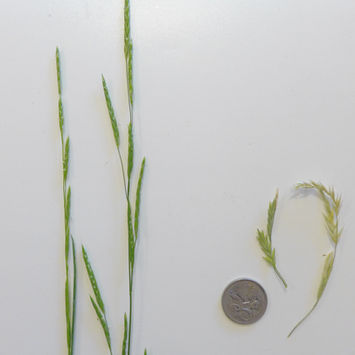
Glyceria australis
Australian Sweet-grass
A semi-aquatic grass with a tall flowering stem (approx. 1m), usually found in waterways. There are also several introduced species of Sweet Grass in Hepburn Shire, all of which are very similar to G. australis.
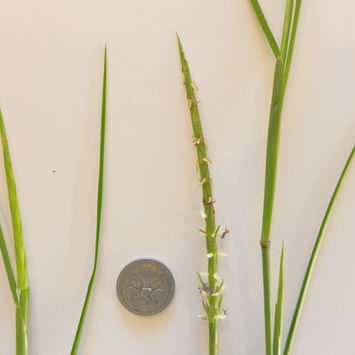
Hermarthria uncinata |
Mat Grass
A mat-forming grass which spreads via underground stems. Typically occurs in low lying areas and adjacent waterways. Often has red highlights on stems and foliage. Most abundant around Creswick, Clunes, Glenlyon. Uncommon or absent in Wombat Forest and surrounds.

Lachnagrostis filiformis |
Common Blown-grass
Very fine seedhead. Often occurs on moist soils and in disturbed areas. Annual and perennial forms of this species occur.

Microlaena stipoides |
Weeping Grass
A widespread and common species throughout Hepburn Shire, occurring in forested and open areas. Can form dense ground cover and is often noted in garden lawns.
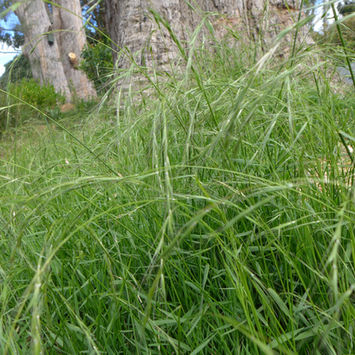
Microlaena stipoides |
Weeping Grass
Sometimes forming large mats, Weeping Grass can be found in many environments including lawns

Phragmites australis |
Common Reed
A tall semi-aquatic grass to 3.5m. Occurs in waterbodies and swamps where it can become dominant.

Poa sp. |
Tussock Grass
Several species of Tussock Grass occur throughout Hepburn Shire. They typically form conspicuous tussocks and can be found in dry or wet, open or forested situations.

Poa amplexicaulis |
Tussock Grass
A fine, green, creeping grass, spreading via stolons to form patches. Red cylindrical sheaths delineate from P. tenera which has split sheaths. Much finer than P. ensiformis also has red sheaths but is far more coarse with wider leaf blades. P. amplexicaulis is relatively abundant in the Wombat Forest, particularly on rocky hillsides.
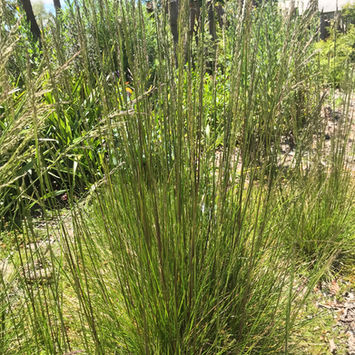
Poa ensiformis |
Sword Tussock-grass
A robust, coarse, tussock-forming grass, spreading via underground rhizomes. Red or purple pigmentation often on leaf sheaths and stems. Confined to areas south and east of Daylesford (high elevation / rainfall areas) within Hepburn Shire. Sparse records within the Wombat Forest, but more common than records suggest. Often on lower parts of hillsides where patches sprawl across the ground.

Poa labillardieri |
Common Tussock-grass
A large grass forming distinct tussocks (not rhizomatous). Healthy leaves are vibrant green on local form. Often abundantly covered in flowering stems / seed-heads through the warmer months. Widespread throughout Hepburn Shire and the Wombat Forest, typically occurring on moist sites and adjacent waterways.
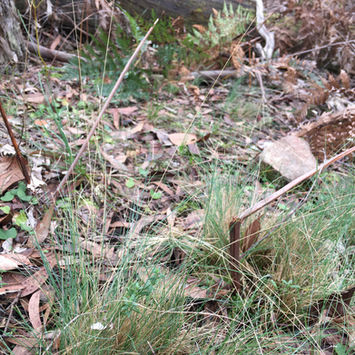
Poa morrisii | Velvet Tussock-grass
A small blue-green tussock with soft leaves covered in fine velvety hairs. Occurs on well drained sites in the Wombat Forest, Creswick Regional Park and Mt. Beckworth.

Poa sieberiana |
Grey Tussock-grass
A widespread tussock grass on dry forested sites throughout Hepburn Shire and the Wombat Forest. Often co-occurs with Rytidosperma pallidum.

Poa tenera |
Slender Tussock-grass
A fine-leaved grass which can spread via above ground stems that root at the nodes. Smooth, thin, folded, bright green leaves. The inflorescence is sparse, comprised of openly spaced short spikelets. Relatively common on damp sites in the southern half of Hepburn Shire, particularly abundant in the Wombat Forest. Distinguish from P. amplexicaulis which has cylindrical sheaths often with red pigmentation.

Rytidosperma sp.
Wallaby Grass
Wallaby Grass is common and widespread throughout Hepburn Shire. Numerous species occur in both forest and open situations.

Rytidosperma sp. |
Wallaby Grass
Pictured: Wallaby Grass dominated grassland in Clunes
INTRODUCED GRASSES

Agrostis capillaris |
Browntop Bent
A common introduced rhizomatous grass widespread throughout Hepburn Shire. Occurs in gardens, agricultural properties, roadsides etc.

Aira sp. |
Hairgrass
An introduced fine annual grass. Widespread throughout Hepburn Shire occurring in forested and open areas.

Anthoxanthum odoratum |
Sweet Vernal-grass
A very common introduced grass throughout Hepburn Shire occurring in bushland, town and agricultural environments. Likely the most widespread species within Hepburn Shire.

Arrhenatherum elatius var. bulbosum |
Bulbous Oatgrass
An introduced grass with bulb-like swollen areas at base. Tall flower spike to 2m. Common from Daylesford through to Trentham and scattered throughout other agricultural areas.
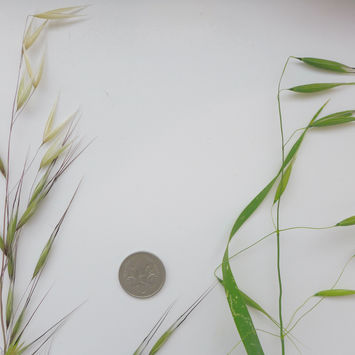
Avena sp. |
Oat / Wild Oat
Common introduced annual with tall flower spike. Occurs throughout Hepburn Shire, particularly in agricultural landscapes.

Briza maxima |
Large Quaking-grass
Introduced annual grass, common in forests of drier parts of Hepburn Shire, often abundant amongst indigenous ground-storey vegetation. Sometimes called Blowfly Grass due to the size, shape and patterning of spikelets.

Briza minor |
Lesser Quaking-grass
An introduced annual grass 20cm to 60cm high. Similar to Briza maxima but smaller spikelets to a few millimetres across. Occurs most commonly in dry forested areas but occassionally found on fertile ground. Widespread across Hepburn Shire, absent or almost so within the Wombat Forest.
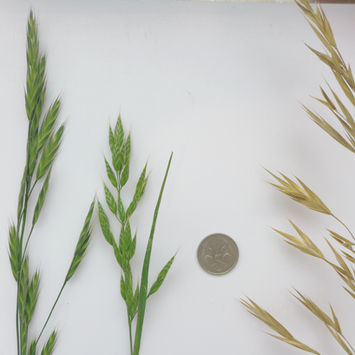
Bromus sp. |
Brome
Introduced annual and perennial grasses. Several species of Brome (e.g. B. catharticus, B. hordeaceus, B. diandrus), are common throughout Hepburn Shire.

Catapodium rigidum |
Fern Grass
Uncommon introduced grass. Very sparse occurrences within Hepburn Shire, recorded at Creswick and on Wombat Hill in Daylesford.
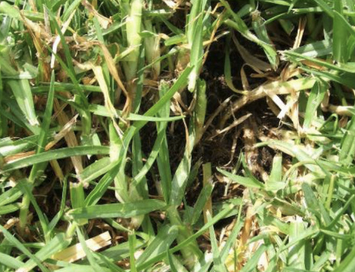
Cenchrus clandestinus |
Kikuyu
A thick-stemmed rhizomatous grass often used in lawns. Yellow-green foliage looks unhealthy through the colder months. Occurs on open sites, rarely within forested areas. Scattered throughout Hepburn Shire, particularly around townships and roadsides in agricultural areas. Absent within the Wombat Forest.

Cenchrus longisetus | Feathertop
Uncommon. A rhizomatous or sometimes tussock forming perennial grass. A soft, dense seedhead. Individual seeds surrounded by long fine hairs >2cm long. Recorded in the west of Hepburn Shire around Creswick and Clunes. Absent in the Wombat Forest.

Cynodon dactylon |
Couch
An introduced rhizomatous spreading grass occurring on roadsides, lawns etc., particularly in the western and northern parts of Hepburn Shire.
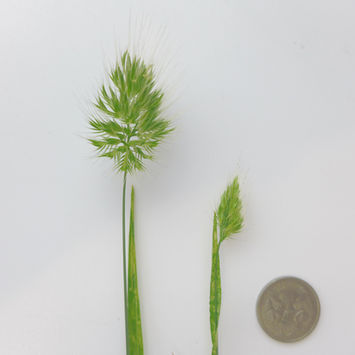
Cynosurus echinatus |
Rough Dogs-tail
Introduced annual grass. Asymmetrical seedhead, most seeds facing similar direction. Scatterred occurrences throughout Hepburn Shire.

Dactylis glomerata |
Cocksfoot
A common introduced perennial grass occurring throughout Hepburn Shire, moreso on fertile soils.

Digitaria sanguinalis |
Summer Grass
An introduced summer-growing annual grass occurring in disturbed area such as roadsides, walking tracks and in cultivated areas. Deep green leaves sometimes with red margins, Widespread across Hepburn Shire.

Ehrharta erecta |
Panic Veldt-grass
An introduced perennial grass. Scattered patches occur throughout Hepburn Shire in disturbed areas and sometimes within forested areas.

Ehrharta longiflora |
Annual Veldt-grass
An introduced annual grass common in drier parts of Hepburn Shire. Occurs on both open and forested sites.
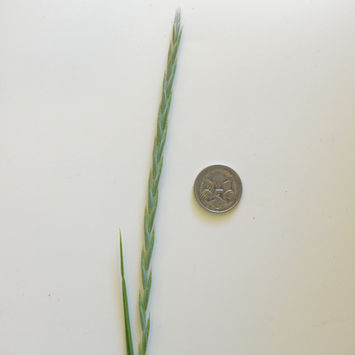
Elytrigia repens |
English Couch
An introduced grass spreading underground via rhizomes. Uncommon, although occurs across Hepburn Shire, particularly on fertile ground (e.g. agricultural properties and gardens).
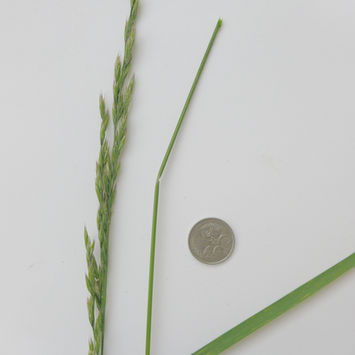
Festuca arundinacea |
Tall Fescue
A thick tufted introduced perennial grass. Not common, but does occur across Hepburn Shire, typically on wet soils (e.g. floodplain, riverbanks).

Holcus lanatus |
Yorkshire Fog
A common and widespread introduced grass throughout Hepburn Shire. Generally occurs on open sites on agricultural properties, roadsides and alongside waterbodies.

Hordeum sp. |
Barley Grass
Introduced annual grasses often occurring in dry spots in agricultural areas. Most abundant in warmer areas in the west and north of Hepburn Shire.

Lolium sp. |
Rye Grass
Common and widespread introduced grasses throughout Hepburn Shire. Deep green slightly glossy leaves. Annual and perennial species occur, each with similar leaves and seedheads.
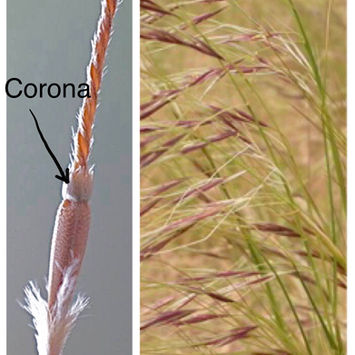
Nassella neesiana |
Chilean Needle-grass
Chilean Needle-grass is a declared noxious weed. It is similar in appearance to some indigenous Spear Grasses. A distinguishing characteristic is the ring (corona) at the base of seed, visible with the naked eye. All introduced Needle Grass species have this corona. Occurs mainly in the west of Hepburn around Creswick and Clunes.
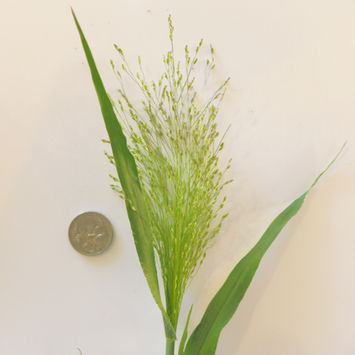
Panicum sp. |
Panic Grass
Introduced annual grasses, relatively uncommon, but occassionally occurring on roadsides and mown areas, particularly in the western half of Hepburn Shire.

Paspalum dilatatum |
Paspalum
A relatively common introduced grass througout Hepburn Shire, particularly on roadsides where there is adequate moisture from road-runoff.
bottom of page
